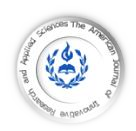
GENERAL INFORMATION
| HOME | ABOUT US | ARCHIVE | AIMS AND SCOP | AUTHORS | REVIEW | SUMIBMIT MANUSCRIPT | EDITORIAL BOARED | PUBLICATION FEE |

| HOME || ABOUT US || ARCHIVES || AIMS AND SCOP || AUTHORS || REVIEW|| SUBMIT MANUSCRIPT || EDITORIAL BOARD |

| Info-AJIRAS-® Journal ISSN 2429-5396 (Online) / Reference CIF/15/0289M |
American Journal of Innovative Research & Applied Sciences

|
American Journal of innovative
Research & Applied Sciences
Research & Applied Sciences
ISSN 2429-5396 (Online)
OCLC Number: 920041286
OCLC Number: 920041286

Authors Contact
*Correspondant author and authors Copyright © 2023:
| Ludovic Ivan NTOM NKOTTO 1,2* |Lionel Jacques NTAMAG 1 | Valdèze Cynthia NDANGANG NZOUAKOI 3 | Judicaël SANDJONG KANDA 4 | Jane Frances MANJEH MA-A 1 | and | Jordan Valdès SONTIA METEKONG 1 |
Affiliation.
1. Laboratoire d’Analyses des Matériaux | Mission de Promotion des Matériaux Locaux (MIPROMALO) | BP 2393, Yaoundé, Cameroun |
2. Laboratoire en Engineering Civil et Mécanique| Ecole Nationale Supérieure Polytechnique de Yaoundé | BP 8390, Yaoundé | Université de Yaoundé 1, Cameroun |
3. Institut Supérieur des Techniques Industrielles et Commerciales de Banganté (ISTIC), BP 9381 | Bangangté, Cameroun |
4. Institut National de la Cartographie(INC) | Direction de la Recherche | Laboratoire de Recherche sur les Risques Naturelles | BP 157, Yaoundé | Cameroun |
This article is made freely available as part of this journal's Open Access: ID | Ludovic-Ref6-15ajiras161222 |
*Correspondant author and authors Copyright © 2023:
| Ludovic Ivan NTOM NKOTTO 1,2* |Lionel Jacques NTAMAG 1 | Valdèze Cynthia NDANGANG NZOUAKOI 3 | Judicaël SANDJONG KANDA 4 | Jane Frances MANJEH MA-A 1 | and | Jordan Valdès SONTIA METEKONG 1 |
Affiliation.
1. Laboratoire d’Analyses des Matériaux | Mission de Promotion des Matériaux Locaux (MIPROMALO) | BP 2393, Yaoundé, Cameroun |
2. Laboratoire en Engineering Civil et Mécanique| Ecole Nationale Supérieure Polytechnique de Yaoundé | BP 8390, Yaoundé | Université de Yaoundé 1, Cameroun |
3. Institut Supérieur des Techniques Industrielles et Commerciales de Banganté (ISTIC), BP 9381 | Bangangté, Cameroun |
4. Institut National de la Cartographie(INC) | Direction de la Recherche | Laboratoire de Recherche sur les Risques Naturelles | BP 157, Yaoundé | Cameroun |
This article is made freely available as part of this journal's Open Access: ID | Ludovic-Ref6-15ajiras161222 |


ABSTRACT
Background: Plastic bottles of the PET type are still one of the most common pollutants found in Cameroon's cities, particularly in its two major metropolises. They are most often found in periods of flooding irrigated by rivers and agglomerated in catchment areas and in discharge works. Government policies to collect them are weak and do not mainly promote their reuse in view of current research. Objective: The aim of this study is to valorise the use of Polyethylene Terephthalate (PET) plastic waste as a binder in the production of roof tiles. Methods: To this end, the melted plastic waste was mixed at different ratios with a 2 mm sieve fraction of Sanaga alluvial sand. The said sand was initially tested and found to be a clean sand, 88.60% sand equivalent, fine grained with a good gradation within the range recommended by NPF18-560. The plastic/sand ratios formulated were: 90/10, 80/20, 30/70, 40/60, 50/50, 60/40, 70/30, 80/20 and 90/10. Results: These samples were subjected to some analysis and it was found that: all the formulations with more than 20% of plastics have a water absorption rate lower than 2.25%, which is in line with the ISO 62: 2008 standard which defines a limit rate of 6% for roof tiles. Furthermore, the porosity test, for the same formulations, shows a rate lower than 4.37%. As for the mechanical characteristics, a high flexural strength ranging from 2.66 to 5.31 MPa was found for formulations ranging from 10 to 50% plastic. Beyond these formulations, the strengths fall continuously for values below 1 MPa. For compressive strength, the following three ratios show better characteristics: 30/70, 20/80 and 90/10 with values of 7.31 MPa, 7.08 MPa and 6.88 MPa respectively. Conclusion: In the end, the ratio with the best characteristics (30/70) made it possible to formulate a Romaine II type tile with optimal impact resistance and waterproofing valued at 540 FCFA per unit.
Keywords: formulation, characterisation, tile, plastic waste, alluvial sand.
Background: Plastic bottles of the PET type are still one of the most common pollutants found in Cameroon's cities, particularly in its two major metropolises. They are most often found in periods of flooding irrigated by rivers and agglomerated in catchment areas and in discharge works. Government policies to collect them are weak and do not mainly promote their reuse in view of current research. Objective: The aim of this study is to valorise the use of Polyethylene Terephthalate (PET) plastic waste as a binder in the production of roof tiles. Methods: To this end, the melted plastic waste was mixed at different ratios with a 2 mm sieve fraction of Sanaga alluvial sand. The said sand was initially tested and found to be a clean sand, 88.60% sand equivalent, fine grained with a good gradation within the range recommended by NPF18-560. The plastic/sand ratios formulated were: 90/10, 80/20, 30/70, 40/60, 50/50, 60/40, 70/30, 80/20 and 90/10. Results: These samples were subjected to some analysis and it was found that: all the formulations with more than 20% of plastics have a water absorption rate lower than 2.25%, which is in line with the ISO 62: 2008 standard which defines a limit rate of 6% for roof tiles. Furthermore, the porosity test, for the same formulations, shows a rate lower than 4.37%. As for the mechanical characteristics, a high flexural strength ranging from 2.66 to 5.31 MPa was found for formulations ranging from 10 to 50% plastic. Beyond these formulations, the strengths fall continuously for values below 1 MPa. For compressive strength, the following three ratios show better characteristics: 30/70, 20/80 and 90/10 with values of 7.31 MPa, 7.08 MPa and 6.88 MPa respectively. Conclusion: In the end, the ratio with the best characteristics (30/70) made it possible to formulate a Romaine II type tile with optimal impact resistance and waterproofing valued at 540 FCFA per unit.
Keywords: formulation, characterisation, tile, plastic waste, alluvial sand.

| ISSN: 2429-5396 (e) | https://www.american-jiras.com | |
| Web Site Form: v 0.1.05 | JF 22 Cours, Wellington le Clairval, Lillebonne | France |
| Web Site Form: v 0.1.05 | JF 22 Cours, Wellington le Clairval, Lillebonne | France |
| FEBRUARY | VOLUME 16 | ISSUE N° 2 | 2023 |
| ARTICLES | Am. J. innov. res. appl. sci. Volume 16, Issue - 2 Pages 42-53 (February 2023)
FORMULATION AND CHARACTERISATION OF A TILE BASED ON PLASTIC WASTE AND ALLUVIAL SAND SANAGA-CAMEROON
FORMULATION ET CARACTÉRISATION D'UNE DALLE À BASE DE DÉCHETS PLASTIQUES ET DE SABLE ALLUVIAL SANAGA-CAMEROUN
| Ludovic Ivan NTOM NKOTTO 1,2* |Lionel Jacques NTAMAG 1 | Valdèze Cynthia NDANGANG NZOUAKOI 3 | Judicaël SANDJONG KANDA 4 | Jane Frances MANJEH MA-A 1 | and | Jordan Valdès SONTIA METEKONG 1 |. Am. J. innov. res. appl. sci. 2023; 16(2):42-53.
| PDF FULL TEXT | | XML FILE | | Abstract and Author Contact |
FORMULATION ET CARACTÉRISATION D'UNE DALLE À BASE DE DÉCHETS PLASTIQUES ET DE SABLE ALLUVIAL SANAGA-CAMEROUN
| Ludovic Ivan NTOM NKOTTO 1,2* |Lionel Jacques NTAMAG 1 | Valdèze Cynthia NDANGANG NZOUAKOI 3 | Judicaël SANDJONG KANDA 4 | Jane Frances MANJEH MA-A 1 | and | Jordan Valdès SONTIA METEKONG 1 |. Am. J. innov. res. appl. sci. 2023; 16(2):42-53.
| PDF FULL TEXT | | XML FILE | | Abstract and Author Contact |